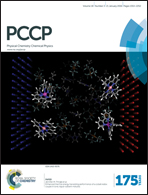Hybrid materials of ZnO nanostructures with reduced graphene oxide and gold nanoparticles: enhanced photodegradation rates in relation to their composition and morphology†
Abstract
Binary and ternary hybrid systems of ZnO possessing nanoparticle and nanorod morphologies on reduced graphene oxide (rGO) and rGO with Au nanoparticles are explored as photocatalysts and a comparative study of their photodegradation performance is presented. Various preparation methods such as solution phase and hydrothermal routes have been employed to produce rGO–ZnO hybrids and rGO–Au–ZnO hybrids to impart different morphologies and defect states in ZnO. All the hybrids exhibit faster photodegradation kinetics and the rGO–Au–ZnO system exhibits the highest rate, five times faster than bare ZnO, followed by the binary systems, rGO–ZnO nanoparticles and nanorods. Various factors such as structure, morphology, charge transfer and adsorption are considered to explain the observed kinetics. Excited state electron transfer from ZnO to both rGO and Au levels facilitates faster dye degradation for rGO–Au–ZnO and is reflected as highly quenched band edge and defect state photoluminescence. Intimate physical interfaces formed between rGO, Au and ZnO in the hybrid material during in situ reactions favour charge transfer across the components. The charge transfer contribution even dominates the adsorption factor and the rGO–Au–ZnO system with a slightly lower adsorption capacity than the rGO–ZnO system exhibits a higher degradation rate. A power law dependence of the photodegradation rate on light intensity is also expressed.


 Please wait while we load your content...
Please wait while we load your content...